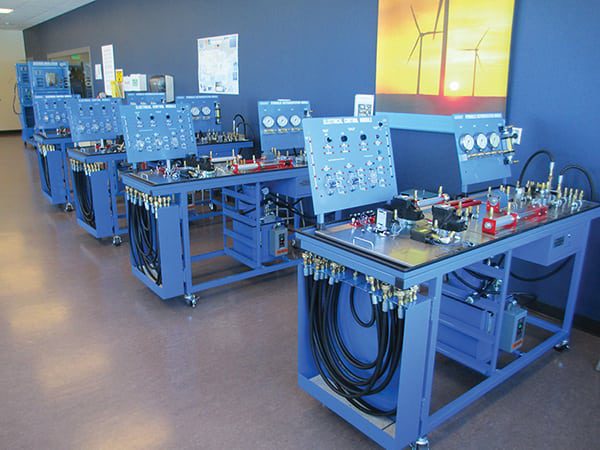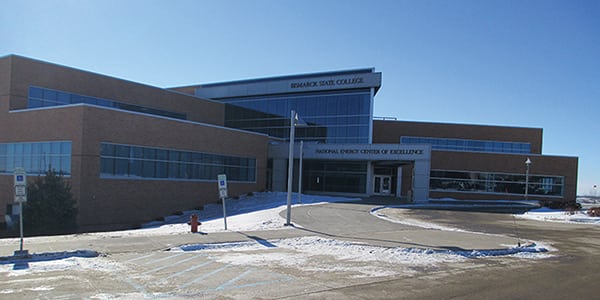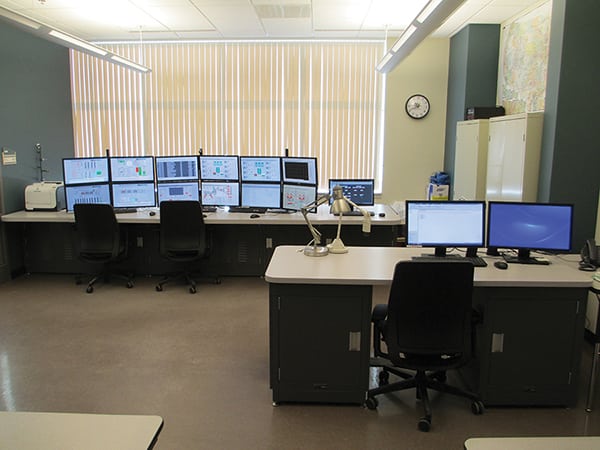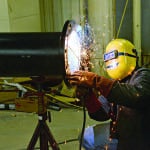With so many career options to choose from, what can the power generation industry do to draw young people into the fold? Well, if you visit a modern educational institution, you may find that technology and advanced simulators can make the profession seem pretty inviting.
It is an exciting time to be a part of the energy industry. New technology is being developed in almost every sector of the business. The coal industry is working on carbon capture and storage solutions, nuclear professionals are creating new Generation IV reactors, solar developments include things like photovoltaic windows for skyscrapers, and energy storage solutions continue to improve, with some experts predicting an explosion of grid-scale deployments as soon as this year (see “The Year Energy Storage Hit Its Stride” in the May issue of POWER, online at powermag.com).
There are a lot of job opportunities in the industry as well. Because such a large number of employees are eligible to retire in this decade, the Energy Providers Coalition for Education (EPCE) expects that 62% of employees in the energy industry will need to be replaced by 2020. For the most part, these jobs must be filled locally and can’t be outsourced overseas, which means personnel with the right training and education can pretty much punch their ticket to a well-paying job with excellent benefits. (For more on education and employment trends, see the sidebar.)
| More Education and Employment Trends
Power generators depend upon personnel with a wide range of backgrounds, from those with certification in specific trades to engineers with degrees in everything from power, mechanical, chemical, and nuclear engineering to computer engineering. That diverse skill and educational background mix makes it difficult to draw a complete picture of trends that may affect specific sectors of the industry, especially as many surveys lump power plant employment into a generic “utilities” or “energy” category. However, a few recent studies of engineering education and energy industry employment trends offer some valuable observations. More Engineers A February 2014 report by the National Science Board notes that the number of bachelor’s degrees in engineering has increased over the past two decades, consistently accounting for about one-sixth of all bachelor’s degrees. It used to be said that potential engineering students and power industry candidates were being drawn to computer science fields instead, but although the number of computer science degrees rose through the dotcom glory days, they have since declined and have leveled off more recently. Nuclear Engineer Training Nuclear power plants have the most rigorous employment requirements and, hence, merit a separate look. A report by the Oak Ridge Institute for Science and Education (ORISE), “Nuclear Engineering Enrollments and Degrees Survey, 2013 Data,” surveyed 32 U.S. universities with nuclear engineering programs and found that the number of college students graduating with majors in nuclear engineering increased between September 2012 and August 2013. According to the report, 655 students received bachelor’s degrees with majors in nuclear engineering in 2013. That’s a 7% increase over 2012, 25% higher than 2011, and the highest number reported in 30 years—but still 20% below the peak years in the 1970s. The 362 nuclear engineering master’s degrees awarded in 2013 (the highest number since 1980) represented an increase of 9% over 2012 and 31% over 2011. Doctorates granted in 2013 (147 total) were 23.5% higher than in 2012, 30% higher than in 2011, and the highest since 1972. However, the ORISE report showed that enrollment in nuclear engineering programs declined from the previous year. In 2013, nuclear engineering enrollments for undergraduate and graduate students were down 9% and 5%, respectively. While the number of bachelor’s degrees awarded is likely to remain in the 630 to 650 range in 2014, the number of students graduating with bachelor’s degrees in nuclear engineering in 2015 will likely decrease to less than 600, the report’s authors concluded. The ORISE report found that most nuclear engineering students didn’t plan to stop with a bachelor’s degree, but for those seeking employment after that degree, nuclear utilities were the most likely employer. Salary Level and Growth Though engineering jobs in the power sector pay quite well when compared with average U.S. salaries, especially when benefits packages are considered, the field does not show the fastest salary growth, according to a 2013 Economic Research Institute report, “Tracking Salary Trends by Education Level and Degree.” Those with a BS in power systems engineering, for example, experienced some of the lowest annual salary growth, an average of 1.97%, among those who held degrees in STEM (science, technology, engineering, and mathematics) fields between 1998 and 2012, while those with a BS in mechanical engineering saw an average 2.08% salary growth. Nevertheless, average 2012 salaries for those two groups ($84,138 and $63,867 respectively) were higher than for those with a BS in fields such as natural resources conservation, environmental sciences, agricultural sciences, and chemistry. Technology Skills Gap A new Manpower survey of the energy industry released May 5, “Strategies to Fuel the Energy Workforce,” found that the jobs employers globally have trouble filling, across all sectors, are the same as those the energy industry is struggling to fill now and into the future: skilled trade workers, technicians, engineers, and IT staff. The report points to three factors overall that are contributing to a shortage of skilled workers at both entry and senior levels: aging workforce, rapid technology and innovation advances, and “a breakdown in education at every level.” The technology gap problem is especially wide for potential job-changers, Manpower found: “The need for technology skills for front-line leadership jobs also make career transfers from the contracting, coal or construction industries difficult. Front-line leaders now use a laptop to report back with spreadsheet programs, and linemen often must troubleshoot electronic devices attached to equipment up on the lines. However, many career changers have limited computer literacy skills.” New, more tech-savvy hires may face the opposite challenge: In some subsectors, such as utilities, they may lack familiarity with the “older analog infrastructure that remains in use today.” Among the Manpower report’s recommendations for addressing the talent shortage are giving vocational training value; marketing to the future pipeline—including underrepresented populations such as military veterans (see the related article in this issue), women, and minorities; developing an intellectually agile workforce; and getting back to STEM basics. How Many Jobs Need to Be Filled? In the U.S., predictions of weak electricity demand growth may be related to projections by the Department of Labor that utilities (as a general category, not just power) will see negative job growth between 2012 and 2022. In fact, it predicts a drop from 554,200 in 2012 to 497,800 in 2022. However, a Manpower chart shows an average of about 50% of U.S. and Canadian energy sector employees eligible for retirement in the next 10 years, so that still leaves a substantial number of positions to fill. In the utilities subsector, the Manpower study projects 100,000 new jobs will be created by 2020, “when a substantial number of utility employees reach retirement age.” It adds that solar and wind sectors will see slower but steady growth by 2020, with wind power jobs projected to double by 2030. —Gail Reitenbach, PhD, Editor |
While the U.S. unemployment rate has been on a steady decline since October 2009, it still stood at 6.7% as of March 2014. People are looking for jobs; the problem is that most of the currently unemployed just aren’t qualified to fill the utility industry’s needs. They don’t have the necessary training for the positions.
Industry-Focused Education
“Across the United States, utility companies—every one of them—has a relationship with a community college or a university,” said Matt Sadinsky, CEO of Prequalified Ready Employees for Power International, a talent development and recruiting company for the energy industry. The connection benefits both partners. The utility gains a valuable future employee resource, because students of the institution will be trained to meet the needs of the company—assuming that the curriculum includes courses appropriate to utility work. The college or university placement office gets a potential hiring resource that is looking for its qualified graduates. It is definitely a win-win situation.
Otter Tail Power Co.’s Big Stone Plant (BSP) offers an example of one such successful partnership. (Disclosure: I am a former BSP employee.) BSP is a 475-MW coal-fired power plant in eastern South Dakota. In 2006, Plant Manager Jeff Endrizzi could see the writing on the wall. The plant, then staffed with 75 personnel, had dealt with very little employee turnover up to that point—averaging only one retirement every 18 months—but Endrizzi projected that the plant would see 51 employees head for the door between 2012 and 2025 based upon the ages of the staff at the time.
“I took a chart to Lake Area Technical Institute (LATI) in Watertown, S.D., in 2006 to explain our expected needs,” Endrizzi said. “LATI had established programs for electronics, robotics, welding, and machining, and we had hired several graduates in the past. However, our upcoming retirements were from the mechanical maintenance and operations departments, and no program at LATI, or any other technical institute in the area, trained candidates for these positions.”
Endrizzi met with Deb Shephard, the vice president of LATI at the time, to discuss possible program additions at the school. Although BSP’s needs alone weren’t great enough to support new programs, Endrizzi encouraged Shepard to visit with other facilities in the area to determine if there was a broader regional need. Those conversations led LATI to develop its energy technology program and, later, an energy operations program. BSP employees continue to serve in an advisory capacity for each of those programs, as well as for LATI’s welding and robotics programs.
“Our rural location can add to the challenges of attracting workers,” said Endrizzi. To counter that, Otter Tail provides scholarships for technical institute students in pertinent programs and works to maintain relationships with the students and instructors in those programs. “Those of us that live here understand and appreciate the benefits of small town life, but that isn’t enough at times,” Endrizzi added.
Online Resources
While utilities work with their local institutions, online learning resources have expanded greatly with the Internet. (See “Going the Distance: Online Courses for Power Industry Professionals” in the June 2012 issue or online at powermag.com.) EPCE was formed in 2000 as a nonprofit alliance of industry individuals, utilities, companies, associations, unions, and other organizations to work together to develop the most relevant and timely energy education programs.
Offered entirely online, EPCE’s educational programs have been developed by the industry, for the industry. EPCE does not offer courses itself; instead, it partners with colleges and universities that are among the best in the nation at providing education online. Classes are fully accredited and completely transferrable.
EPCE’s educational partners include Clemson University, Worcester Polytechnic Institute, Bismarck State College (BSC), Excelsior College, and VHS Collaborative. According to EPCE, studies have shown that students in online courses perform better than those learning the same material through face-to-face instruction, so this new educational model seems to be working.
A Long Track Record
Of course, online classes are not for everyone; some prefer the traditional approach. With its main campus in Bismarck, N.D., BSC has been training personnel to enter the energy industry for quite some time. In 1970, the school identified an industry need for electrical line workers, and it began a program to fill that niche. The program’s success led to the development of the first power plant technology program in the country, which the school began offering in 1976. The program expanded to include process plant technology in 1981.
The school has continued to expand its offerings, including providing online courses beginning in 2000, nuclear training in 2004, and maintenance offerings in 2007, which was also the year that the Department of Energy (DOE) designated BSC as the “National Power Plant Operations Technology and Education Center.” In 2008, the school began offering a bachelor’s degree program in energy management, and the $21 million National Energy Center of Excellence (NECE)—a 106,200-square-foot, state-of-the-art building that currently houses the college’s energy programs and some administrative offices—went into service (Figure 1).
BSC boasts that it has trained thousands of energy employees in all U.S. states. In fact, there was at least one student from every state and Canada among the 1,359 credit-seeking energy program students in 2013. A handful of international learners were part of the enrollment as well.
Modern Facilities
More than two-thirds of the money for BSC’s NECE came by way of donations from businesses and individuals, combined with federal, state, and local funding, the largest single portion of which was $5 million from the DOE. In addition to funding the facility, the money has been used on some high-tech training equipment.
The labs at BSC include a control room simulator (Figure 2), which was paid for by Great River Energy (GRE) in exchange for use of the simulator to train and qualify its operators. The distributed control system for the simulator utilizes software identical to that used at GRE’s Coal Creek Station, a coal-fired power plant with twin 600-MW units. In addition to two on-campus simulators, BSC also has two online simulators that allow student access from anywhere in the country.
Other state-of-the-art labs include a truck-driving simulator that is used to prepare students to obtain their commercial driver’s license, which is required for line workers. The simulator provides a realistic semi-truck driving experience, requiring students to shift gears, maneuver around obstacles, and use mirrors in the same way they would when driving a real truck. The seat and steering wheel are mounted on a moving, vibrating platform that enhances the experience, while large screens display the environment being navigated. The school also owns a semi-truck and trailer for actual on-road training.
An operating thermal power plant with a natural gas–fired, water-tube boiler is another hands-on training tool for students at the college. Complete with a distributed control system, the boiler produces steam to operate a single-stage turbine and small generator. The plant utilizes all of the conventional equipment—deaerator, condenser, feed pumps, and the like—typically included in a utility-scale plant.
Physical pumps, motors, and valves with cutaway sections for easy viewing of internal components are another useful learning tool. In addition to these, BSC has modern training stations for process control systems, mechanical drive systems, electrical control modules, and hydraulic instrumentation components (Figure 3).
 |
| 3. Lab training modules provide hands-on experiences. The electrical control and hydraulic instrumentation modules shown here are just a sample of the mockups used at BSC. Source: POWER/Aaron Larson |
They Gotta Wear Shades
The future’s so bright for most of the power program students that they should probably be wearing welding helmets to cut the glare. Graduates of accredited educational programs catering to the power industry are finding high demand for their services. BSC reports that its placement rate has been in the high 90s for more than a decade and that seems unlikely to change anytime soon, based on the EPCE statistics.
The biggest challenge is finding candidates who are interested in working in a plant or industrial setting. Although the money is generally agreed to be good, many young people feel the jobs are dirty and monotonous. While impressive schools with shiny new toys may coax students in the doors, utilities will need to utilize new techniques to keep new employees engaged and interested.
For example, as a December 2013 report (“Power and Utilities Changing Workforce”) by PricewaterhouseCoopers noted: “Even state-of-the-art utilities, however, still need to be able to speak the language of today’s technology driven generation. And while some organizations have been experimenting with new digital technologies and e-learning approaches to attract and retain younger people, most still lack appropriate training skills and procedures. Training manuals in the form of three-inch ring binders and a classroom-based, instructor-led approach simply may not be attractive to a digital generation that wants to learn largely online and at its own pace.” ■
— Aaron Larson is a POWER associate editor (@AaronL_Power, @POWERmagazine).












